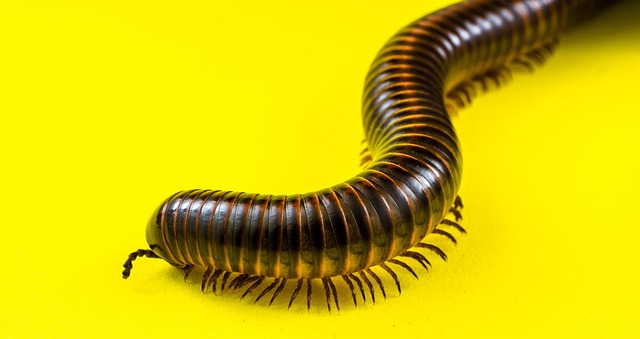Centipedes, drawn to dark, damp areas like basements, kitchens, and bathrooms in homes and commercial spaces, can quickly infest structures through cracks and crevices. Early detection of signs like their distinctive bodies, small holes, or sticky trails is key for effective residential centipede treatment. A multi-faceted approach involving sealing entry points, sanitation, natural repellents, and targeted pesticides prevents infestations. In commercial settings, regular inspections, proactive measures, tailored eco-friendly strategies from professional pest control services, and advanced technology ensure a safe environment through comprehensive residential centipede treatment.
Centipedes, while often overlooked, can transform peaceful homes and bustling commercial spaces into uncomfortable habitats. Understanding these creatures’ behavior is key to effective prevention and control. This article equips you with tailored solutions for both residential and commercial settings, delving into signs of infestation, residental treatments, and proactive commercial measures. Discover how to reclaim your space with our comprehensive guide on successful centipede treatment strategies.
Understanding Centipedes: Behavior and Habitat in Residential and Commercial Spaces
Centipedes are a common pest issue in both residential and commercial settings, often causing concern among homeowners and business owners alike. Understanding their behavior and habitat is crucial for effective centipede treatment. In residential areas, centipedes typically seek shelter in dark, damp corners of homes, such as basements, kitchens, and bathrooms, where they can easily access water sources and potential food items like insects and spiders. They are attracted to cracks and crevices, making it easy for them to find entry points and establish colonies.
In commercial spaces, centipedes may inhabit areas with similar environmental conditions: dark, humid corners, behind appliances, under flooring, or in basements. They can also be found in offices, especially those with outdoor access, as they are drawn to the organic matter and insect populations often present in landscapes around buildings. A thorough inspection by professionals is key to identifying their hiding spots and determining the extent of the infestation. Once identified, tailored solutions for residential centipede treatment, such as sealing entry points, applying targeted pesticides, or implementing integrated pest management strategies, can effectively eliminate these pests from both home and work environments.
Identifying Signs of Centipede Infestation
Centipedes are elusive pests that can quickly invade both residential and commercial spaces, often going unnoticed until their population grows. Identifying signs of a centipede infestation is crucial for effective residential centipede treatment. One of the most obvious indications is the presence of these creatures themselves—long, slender bodies with multiple pairs of legs—in various corners, cracks, and crevices. They tend to prefer dark, damp areas such as basements, bathrooms, or kitchens.
Homeowners may also notice small, irregular holes in fabrics or other materials, as centipedes feed on various organic items like textiles, wood, and even dead insects. Faint trails of a sticky substance are another clue, left behind by the centipedes as they move. Early detection through these signs is key to preventing a full-blown infestation and requires immediate action for effective residential centipede treatment.
Effective Residential Centipede Treatment Strategies
When it comes to dealing with centipedes in your home, a comprehensive approach is key. Effective residential centipede treatment involves a multi-faceted strategy that combines prevention, sanitation, and targeted pest control measures. Start by identifying and sealing entry points—cracks, gaps around pipes or wires, and windowsills—to prevent these creatures from infiltrating your living space. Regularly vacuum and dust to remove potential food sources, especially in dark corners and under furniture.
For existing centipede infestations, a combination of natural repellents and professional treatments can be highly effective. Natural solutions like diatomaceous earth or essential oils can deter centipedes while being safer for residents and pets. However, for severe cases, it’s recommended to consult with pest control professionals who can apply targeted pesticides in hard-to-reach areas, ensuring a more permanent solution to your residential centipede problem.
Commercial Centipede Control Measures: A Proactive Approach
In commercial spaces, a proactive approach to centipede control is essential to prevent widespread infestations that can disrupt business operations and damage reputation. Regular inspections are key; identifying potential entry points and vulnerable areas allows for swift action. Professional pest control services specializing in residential and commercial treatments can implement tailored strategies using eco-friendly methods and advanced technology.
These measures include sealing gaps, cracks, and crevices to limit centipede access, deploying targeted baits and traps, and treating infested areas with minimal impact on the environment or existing ecosystems. By combining these proactive steps, businesses can effectively manage and control centipede populations, ensuring a safe and hygienic environment for both employees and customers alike.
In addressing centipede infestations, a tailored approach is key. Whether in residential or commercial settings, understanding these creatures’ behavior and habitat is crucial for effective control. By identifying signs early on and implementing targeted strategies, homeowners and business owners alike can prevent and manage centipede problems successfully. For commercial spaces, proactive measures ensure a pest-free environment, enhancing operations and maintaining a professional image. With the right knowledge and methods, it’s possible to keep these pests at bay and enjoy peaceful, pest-free living or working spaces.
